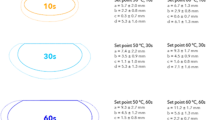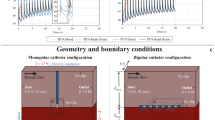Abstract
Background
Currently, RF ablation is limited in its ability to deliver deep lesions, as most of the energy delivered to the tissue is dissipated in the first few millimeters from the catheter tip. Focused electric field (FEF) is a novel technology with the potential to ablate deeper than currently available RF catheters. This work is the first proof of concept of FEF technology.
Objective
To introduce FEF technology and demonstrate its feasibility as an ablation tool.
Methods
We constructed a FEF catheter with a truncated dome-shaped tip, creating a toroidal ablating surface. We performed ablation ex vivo in porcine hearts and examined ablation characteristics using both tissue sectioning and real-time thermal imaging.
Results
RF lesions were 9.1 ± 1.0 mm wide by 6.1 ± 1.1 mm deep with ablation using a conventional irrigated tip catheter (Thermocool SF). In contrast, lesions created using FEF ablation were 12.8 ± 1.6 mm wide and 14.0 ± 1.6 mm deep. Steam pops were less frequent in the FEF group. Thermal imaging demonstrated that in contrast to an irrigated tip RF catheter, the FEF catheter generated a uniform temperature profile down to a maximum depth exceeding 15 mm.
Conclusion
This study is the first proof of concept of FEF technology. Using a novel toroidal catheter tip design, the electric field remains confined to a narrow tissue region, thus avoiding the rapid fall off in energy delivery from the tissue surface inherent to current RF catheter designs. FEF ablation may allow delivery of deeper ablations lesions with potentially lower risk of tissue hyperthermia than conventional catheters. Future studies are needed.



Similar content being viewed by others
References
Haines DE. Cooking with radiofrequency energy: what is the right recipe? JACC Clin Electrophysiol. 2018;4(4):480–2.
Haines DE, Watson DD. Tissue heating during radiofrequency catheter ablation: a thermodynamic model and observations in isolated perfused and superfused canine right ventricular free wall. Pacing Clin Electrophysiol. 1989;12(6):962–76.
Nakagawa H, et al. Comparison of in vivo tissue temperature profile and lesion geometry for radiofrequency ablation with a saline-irrigated electrode versus temperature control in a canine thigh muscle preparation. Circulation. 1995;91(8):2264–73.
Eick OJ. Factors influencing lesion formation during radiofrequency catheter ablation. Indian Pacing Electrophysiol J. 2003;3(3):117–28.
Nguyen DT, et al. Radiofrequency ablation using an open irrigated electrode cooled with half-normal saline. JACC Clin Electrophysiol. 2017;3(10):1103–10.
Nguyen DT, et al. Prospective multicenter experience with cooled radiofrequency ablation using high impedance irrigant to target deep myocardial substrate refractory to standard ablation. JACC Clin Electrophysiol. 2018;4(9):1176–85.
Yavin HD, et al. Pulsed-field ablation in ventricular myocardium using a focal catheter: the impact of application repetition on lesion dimensions. Circ Arrhythm Electrophysiol. 2021;14(9):e010375.
Koruth JS, et al. Bipolar irrigated radiofrequency ablation: a therapeutic option for refractory intramural atrial and ventricular tachycardia circuits. Heart Rhythm. 2012;9(12):1932–41.
Arai M, et al. Successful bipolar radiofrequency catheter ablation of ventricular premature complexes arising from the anterolateral papillary muscle of the left ventricle. Heart Rhythm Case Rep. 2019;5(9):472–5.
Della Bella P, et al. Bipolar radiofrequency ablation for ventricular tachycardias originating from the interventricular septum: safety and efficacy in a pilot cohort study. Heart Rhythm. 2020;17(12):2111–8.
Gizurarson S, et al. Bipolar ablation for deep intra-myocardial circuits: human ex vivo development and in vivo experience. Europace. 2014;16(11):1684–8.
Tokioka S, et al. Bipolar radiofrequency catheter ablation between the left ventricular endocardium and great cardiac vein for refractory ventricular premature complexes originating from the left ventricular summit. J Arrhythm. 2020;36(2):363–6.
Sandhu A, et al. Use of half-normal saline irrigant with cooled radiofrequency ablation within the great cardiac vein to ablate premature ventricular contractions arising from the left ventricular summit. Pacing Clin Electrophysiol. 2019;42(3):301–5.
Stevenson WG, et al. Infusion needle radiofrequency ablation for treatment of refractory ventricular arrhythmias. J Am Coll Cardiol. 2019;73(12):1413–25.
Da-Wariboko A, et al. Double-balloon technique for retrograde venous ethanol ablation of ventricular arrhythmias in the absence of suitable intramural veins. Heart Rhythm. 2020;17(12):2126–34.
Briceno DF, Valderrabano M. Recurrent perimitral flutter due to vein of Marshall epicardial connections bypassing the mitral isthmus: response to ethanol infusion. Circ Arrhythm Electrophysiol. 2014;7(5):988–9.
Kreidieh B, et al. Retrograde coronary venous ethanol infusion for ablation of refractory ventricular tachycardia. Circ Arrhythm Electrophysiol. 2016;9(7):e004352.
Tung R, et al. Simultaneous endocardial and epicardial delineation of 3D reentrant ventricular tachycardia. J Am Coll Cardiol. 2020;75(8):884–97.
Author information
Authors and Affiliations
Corresponding author
Ethics declarations
Ethics approval
Not required for this work.
Informed consent
No research subjects were used for this research.
Conflict of interest
Three of the authors (PM, MB, YM) share a pending patent for the principle and use of focused field ablation and interest in Focused Therapeutics.
Additional information
Publisher’s note
Springer Nature remains neutral with regard to jurisdictional claims in published maps and institutional affiliations.
Supplementary Appendix
ESM 1
(DOCX 1528 kb)
Rights and permissions
About this article
Cite this article
Huang, H.D., Melman, P., Brosh, M. et al. Focused electric field (FEF) ablation in a left ventricular and infrared thermal imaging model: a proof-of-concept study. J Interv Card Electrophysiol 66, 125–131 (2023). https://doi.org/10.1007/s10840-022-01276-z
Received:
Accepted:
Published:
Issue Date:
DOI: https://doi.org/10.1007/s10840-022-01276-z




